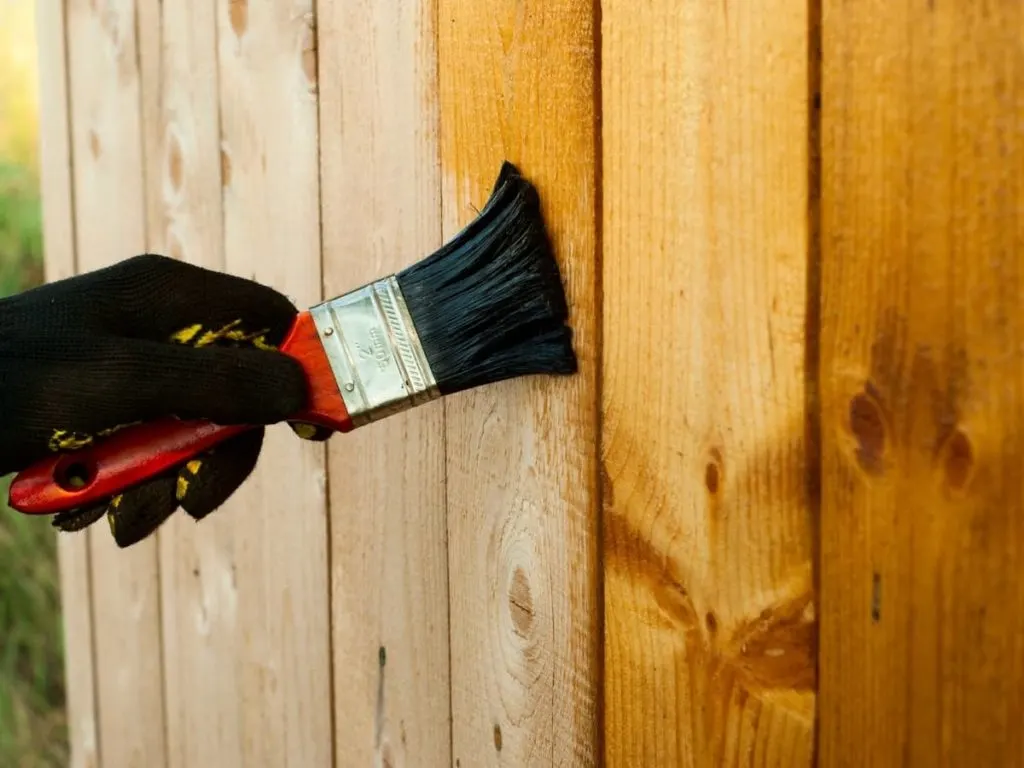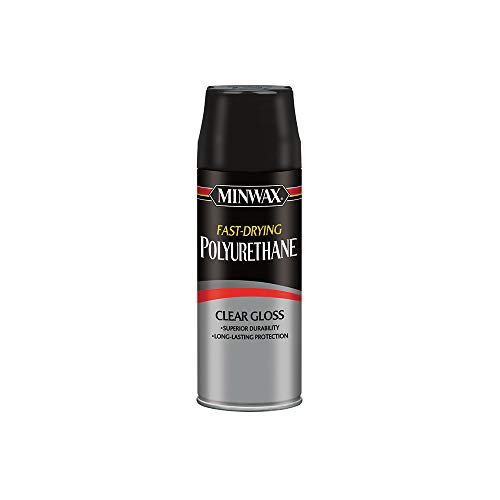Having a toddler around the house leads to having stickers all around the house. But peeling them to remove may harm the wall. Besides, removing them also means you get to lose the memories of your little one’s creativity.
So instead of removing the stickers, you may want to preserve them. But, it becomes important to use the appropriate sealing agent to protect the stickers along with the surface.
Read till the end to know exactly what you need to use to protect your beloved memories.
Can You Polyurethane Over Stickers?
You can use polyurethane over stickers. Polyurethane protects surfaces and what’s underneath it. But it is not suitable for all types of surfaces as it can cause harm to the sensitive surface. It’s pretty important to ensure the surface quality before using polyurethane over the stickers.
Table of Contents

Surfaces can get damaged, and stickers over surfaces are more sensitive. The polished stickers can fade color and can crack. Polyurethane soothes the surface and keeps them shining.
Polyurethane sprays are used on different surfaces. Based on surface quality, it determines if you can use polyurethane or not. But there might be confusion regarding the polyurethane coat and different surfaces. Read below know about them
Polyurethane over vinyl stickers or vinyl decals:
Yes, polyurethane protects vinyl decals. Vinyl stickers are not so expensive and usually use on walls for decorations.
Polyurethane makes a polished stain over vinyl stickers. Decals look more graceful, and it is easy to clean polished stickers every day.
Some vinyl decals need multiple coats of polyurethane to get rid of damages. It needs continuous checkups for some weeks.
Polyurethane over paper stickers:
Paper stickers mostly gained popularity among children. It’s easy to coat the paper stickers through polyurethane.
Though paper stickers protect from peeling and damages, it needs to check twice. Some paper stickers crap for polyurethane. Extra awareness can protect your paper stickers from wasting.
There is a kind of polyurethane which is ‘oil polyurethane’. This causes the most harm to paper stickers. Avoid oil polyurethane and use a watery one. This lasts longer and seems perfect for paper stickers.
Polyurethane over stickers on wood:
Absolutely, you can. Polyurethane Sealant mostly uses for filling wood gaps, redecorating faded designs, and protect stickers from peeling on woods.
Wood stickers are decorated for a pleasant sight. If you want to keep it last, stickers need polyurethane.
It’s the easiest technique to make wood stickers polished. Spray or polish it on a wooden surface, so you’ll get the shiny and smooth design.
Polyurethane over peel and stick tile:
Peel and stick tiles can be protected by polyurethane. You can get branded dyeing polyurethane to spray on tiles.
Stick tile’s edges are sharp sometimes. Cracked surfaces need more attention to spray polyurethane.
Damaged floors are so irritating. It causes harm to babies and old persons too. Using polyurethane keeps tiles more glossy, resistant, and long-lasting. Choose brand carefully. Some brands cause harm to tiles and damages early.
Tips to apply polyurethane over stickers:
Applying polyurethane gives perfect results if you follow some tricks. It can be a time-saver for you. Following the below steps help you to understand.
Stir Polyurethane, not shake:
Polyurethane cans have instructions over them. Read carefully. Instructions give clear visualization of applying polyurethane.
Never shake the polyurethane cans. Shaking creates bubbles inside. If you shake, final polishing will show up bubbles.
Simply stir the liquid of polyurethane. It gives a perfect shade after applying polyurethane.
Some surfaces have cracks between them. If you ever find bubbled polyurethane, apply them in between cracks. It helps to fill the blank cracks and looks good.
Apply thin coatings:
Never coat so much on the same surface. Coat thin for the first time. Surfaces need to polish over and over again. It gives beautiful shades. Apply thin each time.
If you apply thick, it will look imperfect. There will be no use if coatings don’t give perfect results.
Use proper ventilation:
It is important to dry applied polyurethane. Don’t change the place of the polished surface.
Polyurethane needs hours to get dry. Avoid waiting for only a few minutes, and rub the place. Wait until it dries properly.
Use proper air. Proper ventilation gives a shinier surface. Clean polished surfaces every day to avoid dust and pollution.
Work with bright-side light:
It’s good to polish over stickers with bright-side light. It’s always suggested that apply polyurethane on flat surfaces. Some apply polyurethane coat heavily. Using thin coats gives the perfect result.
After applying the polyurethane, observe it in bright light. Bright lights reflect on the shade of polyurethane. In light imperfections can easily be noticed.
In light, if some surfaces are noticed imperfect, those surfaces can be polished again.
What is best to seal stickers and vinyl decals on glass and wood?
You can use both to seal on glass and wood. The best is vinyl decals on wood. Stickers on glass need more attention than vinyl decals on surfaces.
Applying spray-on glasses never lasts long. You can see some official doors, where glasses are polished with designs. But the design is not well-formatted.
Applying polyurethane cans thinly is the best sealing solution. Dry properly to seal stickers and vinyl decals on glass and wood.
Which is better, Polyurethane or polyacrylic over vinyl decal?
Obviously, polyurethane is better than polyacrylic. Polyacrylic is less durable and used in interior designs only.
It is observed that polyacrylic is less toxic and dangerous. While it is not dry, it can be inside fire too. But polyurethane required more chemicals to last long.
Vinyl decal is less expensive, but nobody wants to change designs always. Using polyacrylic makes surface shiner too but it turned yellow after few days.
Applying polyurethane thinly protects vinyl decals more. Products that last long are obviously better than others.
Can you put polyurethane over the sticky stain?
Well, you can put polyurethane over a sticky stain. But it’s risky. Sticky stains need a longer time to get dry.
Applying polyurethane on a sticky stain makes trouble sometimes. Polyurethane adheres to stains without the surface. This makes the surface pale after few weeks.
When the stain is unable to completely sink into the wood’s fibers, it becomes sticky. Stain is a dye, yet it cannot simply conceal faults. To modify the color from the inside, it works with the natural shape of the wood.
You need to re-stain the sticky one if it couldn’t dry in 12 hours.
Can you put polyurethane over sticky epoxy?
Yes, you can put polyurethane over sticky epoxy. It’s best to use polyurethane over your sticky epoxy project. As polyurethane sealant, it makes the epoxy shiner. As epoxy is resin, polyurethane protects it from UV rays and scratches.
Though sticky epoxy can be regained by polyurethane, it needs to recheck. Using polyurethane on epoxy, you need to be aware of some ideas.
Recheck the quantity:
Check the ratio of liquid polyurethane. You need to pour a very thin layer. Thin polishing will soothe eyes and looks perfect.
A mixture of polyurethane will damage the epoxy if you don’t follow the amount ratio.
Polish and dry thoroughly:
Applying polyurethane is not enough. Epoxy needs to dry properly. Make sure to polish over the entire epoxy. If the surface left one corner from polishing, it will look bad. Dry for few hours to get your best result.
Can you lacquer over stickers?
Yes, you can lacquer over stickers. If you lacquer over stickers, it gives permanent protection from stains and damages. Lacquer is a long-lasting process. If you ever lacquer over stickers, you can’t vanish the sticker further.
To remove the stickers, you need to remove the lacquer first. After removing lacquer, you can remove the stickers.
Applying lacquer multiple layers makes stickers more protected. If you ever want to keep stickers forever, you can lacquer them.
Can you stain over stickers?
Yes, you can stain over stickers. But make sure you applied polyurethane on the top of the stain. Whenever you stain over stickers, it adheres to the stickers only. It can’t adhere to the surface. So, soon the design will destroy.
Applying polyurethane on top will resolve this problem. The stain will adhere to the surface too. Design and stickers will never destroy.
Steps to stain over stickers
- Before doing anything, clean the surface. Use dry cloths to wipe the dirt.
- Wipe down designed stickers. Make sure to clean it too.
- Prepare polyurethane. Stir it carefully. Avoid shaking it.
- Carefully polish over the stain.
- After polishing polyurethane successfully, stain the stickers.
- Use a smooth brush to do the process.
- Dry the entire surface. Wait for the complete dry.
Final thoughts
To protect stickers, polyurethane works as a damage savior and can be applied over. Based on the surface quality, polyurethane type can change too. Use required type to protect surface and sticker damages. And polyurethane over stickers will make them last longer.




